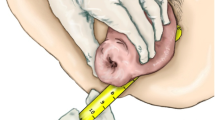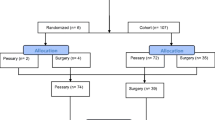Abstract
Introduction and hypothesis
The purpose of this study was to evaluate symptoms associated with pelvic organ prolapse (POP) and quality of life (QOL) improvement in patients who continue ring pessary use at 1 year.
Methods
Seventy-seven symptomatic POP patients had successful fitting, and 64 patients (83.1%) continued use at 1 year. The Thai version of Prolapse Quality of Life (P-QOL) questionnaire was used to evaluate symptoms associated with POP and impact on QOL. A higher score represents a greater impairment on the QOL, whereas a lower score represents a better QOL.
Results
Mean age was 66.7 ± 8.6 years, median parity was 4 (range 0–10), 59 patients (92.2%) were menopausal, and none had received hormone treatment. Only nine patients (14.1%) were sexually active. Most patients were in the advanced stage of POP—32.8% stage 3 and 29.7% stage 4. Improvement of prolapse symptoms and voiding difficulty were reported in 100% and 85.7% of the patients, respectively. Among patients who had lower urinary tract symptoms at pre-treatment, about half of patients improvement in frequency, urgency, and urgency urinary incontinence. Only 9.1% of the patients had improvement in stress urinary incontinence (SUI), and 23.8% of the patients reported new onset of SUI (de novo SUI). The median score from all P-QOL domains except personal relationships were significantly decreased after 1 year of ring pessary use. The median total scores at baseline and at 1 year were 40 and 8, respectively (P < 0.001).
Conclusions
Ring pessary is an effective non-surgical treatment to alleviate symptoms associated with POP. It can improve QOL in symptomatic POP patients.

Similar content being viewed by others
References
Cundiff GW, Weidner AC, Visco AG, Bump RC, Addison WA (2000) A survey of pessary use by members of the American Urogynecologic Society. Obstet Gynecol 95:931–935
Manchana T (2011) Ring pessary for all pelvic organ prolapse. Arch Gynecol Obstet 284:391–395
Tincello DG, Alfirevic Z (2002) Important clinical outcomes in urogynecology: views of patients, nurses and medical staff. Int Urogynecol J Pelvic Floor Dysfunct 13:96–98
Digesu GA, Khullar V, Cardozo L, Robinson D, Salvatore S (2005) P-QOL: a validated questionnaire to assess the symptoms and quality of life of women with urogenital prolapse. Int Urogynecol J 16:176–181
Manchana T, Bunyavejchevin S (2010) Validation of the Prolapse Quality of Life Questionnaire (P-QOL) in Thai version. Int Urogynecol J Pelvic Floor Dysfunct 21:985–993
Bump RC, Mattiasson A, Bo K, Brubaker LP, DeLancey JO, Klarskov P, Shull BL, Smith AR (1996) The standardization of terminology of female pelvic organ prolapse and pelvic floor dysfunction. Am J Obstet Gynecol 175:10–17
Clemons JL, Aguilar VC, Tillinghast TA, Jackson ND, Myers DL (2004) Patient satisfaction and changes in prolapse and urinary symptoms in women who were fitted successfully with a pessary for pelvic organ prolapse. Am J Obstet Gynecol 190:1025–1029
Bai SW, Yoon BS, Kwon JY, Shin JS, Kim SK, Park KH (2005) Survey of the characteristics and satisfaction degree of the patients using a pessary. Int Urogynecol J Pelvic Floor Dysfunct 16:182–186
Wu V, Farrell SA, Baskett TF, Flowerdew G (1997) A simplified protocol for pessary management. Obstet Gynecol 90:990–994
Fernando RJ, Thakar R, Sultan AH, Shah SM, Jones PW (2006) Effect of vaginal pessaries on symptoms associated with pelvic organ prolapse. Obstet Gynecol 108:93–99
Barber MD, Walters MD, Cundiff GW, the PESSRI Trial Group (2006) Responsiveness of the Pelvic Floor Distress Inventory (PFDI) and Pelvic Floor Impact Questionnaire (PFIQ) in women undergoing vaginal surgery and pessary treatment for pelvic organ prolapsed. Am J Obstet Gynecol 194:1492–1498
Komesu YM, Roger RG, Rode RG, Craig EC, Gallegos KA, Montoya AR, Swartz CD (2007) Pelvic floor symptom changes in pessary users. Am J Obstet Gynecol 197(620):e1–e6
Patel M, Mellen C, O’Sullivan DM, LaSala CA (2010) Impact of pessary use on prolapse symptoms, quality of life, and body image. Am J Obstet Gynecol 202(499):e1–e4
Ko PC, Lo TS, Tseng LH, Lin YH, Liang CC, Lee SJ (2011) Use of a pessary in treatment of pelvic organ prolapse: quality of life, compliance, and failure at 1-year follow-up. J Minim Invasive Gynecol 18:68–74
Romanzi LJ (2002) Management of the urethral outlet in patients with severe prolapse. Curr Opin Urol 12:339–344
Kuhn A, Bapst D, Stadlmayr W, Vits K, Mueller MD (2009) Sexual and organ function in patients with symptomatic prolapse: are pessaries helpful? Fertil Steril 91:1914–1918
Barber MD (2007) Questionnaires for women with pelvic floor disorders. Int Urogynecol J 18:461–465
Conflicts of interest
None.
Author information
Authors and Affiliations
Corresponding author
Rights and permissions
About this article
Cite this article
Manchana, T., Bunyavejchevin, S. Impact on quality of life after ring pessary use for pelvic organ prolapse. Int Urogynecol J 23, 873–877 (2012). https://doi.org/10.1007/s00192-011-1634-6
Received:
Accepted:
Published:
Issue Date:
DOI: https://doi.org/10.1007/s00192-011-1634-6




